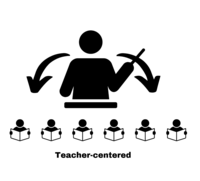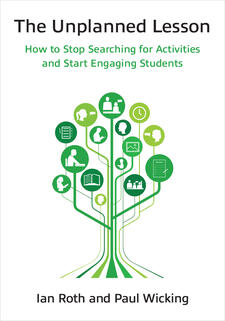From Student-centered to Learning-centered
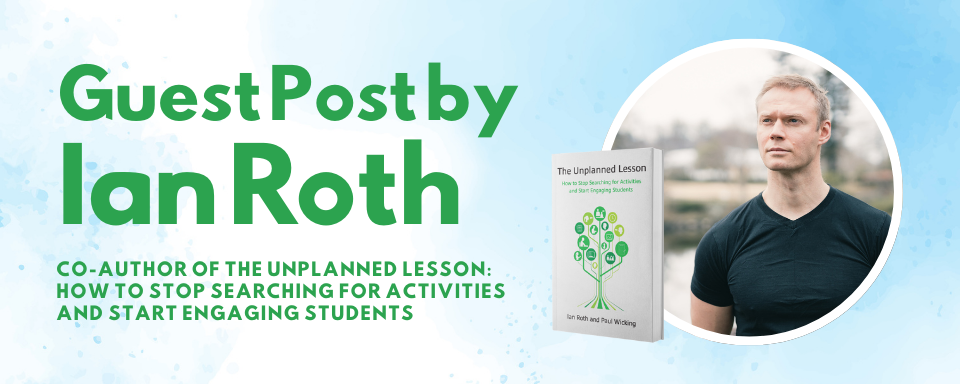
This guest author post is by Ian Roth, co-author with Paul Wicking of The Unplanned Lesson: How to Stop Searching for Activities and Start Engaging Students, from the University of Michigan Press. The book is available in paperback and as an accessible ebook.
While it is long past the time when teacher-centered classrooms were considered the ideal, many educators have yet to grapple with the limitations of the student-centered approach that has taken its place. In The Unplanned Lesson: How to Stop Searching for Activities and Start Engaging Students we suggest a new paradigm—that of the learning-centered classroom. Let’s start by defining each of these key terms.
Teacher-centered education
Teacher-centered lessons are those in which the teacher is the focal point, providing the content to be learned and determining the means whereby that learning is to take place. The teacher enjoys the largest share of attention, spends the most time speaking, and is generally the most active party. Metaphorically, the teacher is the composer and conductor, guiding the class through a predictable performance.
While the teacher-centered approach has fallen into disfavor, it is not entirely without redeeming qualities. For example, consider the popularity of TED Talks, podcasts, audiobooks and, indeed, the vast majority of online learning materials. They are rarely hands-on, student-led learning experiences, instead consisting of a one-way flow of information communicated by someone occupying center stage, often both figuratively and literally, and acting as a teacher. For whatever else they fail to accomplish, teacher-centered lessons are a highly effective way to transmit information. In contrast with a written text, a proficient teacher will bring the content to life while tailoring their delivery in response to cues from their audience. Though a high-quality orchestral performance is largely predictable, that does not mean it cannot be powerful and enjoyable for all involved.
Of course, transmission does not necessitate comprehension any more than information reliably produces understanding. Given this, the cardinal flaw of teacher-centered education is the passivity of the would-be learners. Consuming information can be done passively; digesting it can only be achieved actively. Thus, an approach to learning that is only teacher-centered leaves out the later, deeper levels of learning. As a result, neither the combination and comparison that lead to the material being networked into existing knowledge structures, nor the application and iteration that lead to its embodiment will find adequate support in a purely teacher-centered environment. While the clarity that is characteristic of this approach is initially necessary, it lacks the complexity needed to challenge students seeking a deeper understanding. For this reason, too much teacher-centered education can transform eager learners into disengaged observers.
Student-centered education
By contrast, student-centered approaches pull the teacher off the stage and, in some sense, remove the stage altogether. The focus moves to the individual learners, each of whom are metaphorically given the reins to guide their own learning experience. The lesson is guided by curiosity and questions. The essential rationale for making this shift is that knowledge cannot be transmitted, it can only be constructed by individuals in a way that is unique to themselves.
The student-centered approach has much to recommend it. Among these strengths is its emphasis on learning as an active endeavor. It honors the natural curiosity and resourcefulness of learners, encouraging them to take responsibility for their own education. It also relieves the pressure to be an expert from the teachers, freeing them to be more experimental and playful. Perhaps most profoundly, it assumes and, in so doing, promotes a positive vision of students. Rather than being empty vessels motivated to learn by the deftly employed carrots and sticks of their teacher (what the management theorist Douglas McGregor called “Theory X”), they are recast as resourceful, self-motivated learners, alienated and dehumanized by the imposed carrots and sticks (“Theory Y“ in McGregor’s parlance). For educators, this constitutes a reversal of assumptions—one of the deepest and, thus, most consequential kinds of shifts. This shift is, by and large, a positive one.
Of course, there is no such thing as a perfect approach. Expertise, both in the content to be learned and in the learning process itself, cannot be replaced by the trial-and-error process of even the most tirelessly curious novice. As with the terrestrial landscape that surrounds us, the landscape of knowledge is scattered with minor peaks. Trial-and-error alone is an efficient means by which to arrive at a peak, but once there it can trap the learner into believing there are no higher peaks to be reached since whatever they try sends them back downhill. Part of expertise is having comprehensive knowledge of the geography associated with a discipline or skillset. With this comes the ability to guide new learners towards the highest possible peaks or to convince them to abandon the minor ones they have discovered for the promise of something better.
There is the further problem that, while understanding and wisdom cannot be learned via transmission, knowledge absolutely can. That is, knowing that Mt. Fuji is 3,776 meters tall, that dogs are colorblind, or which foods contain Zinc can only be efficiently transmitted to the learner by a source that already possesses this knowledge. The stage of learning during which we come to know new information may be the least complex, but it is nonetheless indispensable. Putting students at the center of the lesson is akin to appointing them to act as guides in a land they barely know. Regardless of their ability to discover some points of interest, they have no reliable way to account for what they’ve left unexplored.
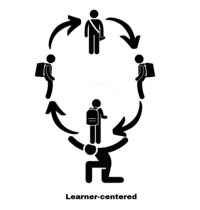
Learning-centered education
For whatever else it accomplishes, the purpose of teaching, of classes, and of education itself is to produce learning. But, since students learning that they don’t enjoy reading or that they are irredeemably bad at math are hardly outcomes aligned with the mission of education, not just any learning will do. At its best, education aims to produce the kind of learning that will serve individuals and benefit the larger systems in which they are embedded (be they social, cultural, economic, etc.). This pursuit is neither teacher- nor student-centered. Consider for a moment whether a successful sales department would refer to itself as salesperson-centered or customer-centered. How about a championship level sports team (coach- or player-centered) or an elite military unit (commander- or soldier-centered)?
Clearly, these characterizations are inappropriate because in each case the team in question operates with its orienting purpose—make sales, win games, complete the mission—at the center. The necessary result is that the onus of leadership and action is shared and fluid, shifting in response to the demands of the situation. Just as the student-centered approach offered a different conception of the individual, a learning-centered approach offers a new understanding of a class. The long history of education serving, whether explicity or not, as a sorting mechanism has left us with a zero-sum mentality according to which a class is best understood as a collection of students competing for a limited supply of respectable grades. If learning is truly to be the goal, then a class must be reframed as a learning team capable of behaving synergistically. Examples include one student teaching something to another and both benefiting from the interaction, the good fortune of one student’s question revealing the unknown unknowns of another, or the success of one member creating opportunities for everyone else.
Much like a focused discussion, a learning-centered classroom drives towards greater understanding and/or solutions. The participants take turns contributing, but do so with a shared sense of purpose. Unlike a discussion, there are often explicit success criteria (e.g. by the end of the class, everyone should be able to identify and explain the three branches of government or make a sentence using any of these relative clause connectors). The teacher’s role is also hard to pin down. By turns, they might act as a moderator, as a fact checker, as a provider of context, and as the organizer of the discussion. What is certain, however, is that attentiveness, responsiveness, and adaptability are the key capacities of learning-centered teaching. The teacher’s primary responsibility is to pay attention to the class so they can provide what is most likely to support its progress towards achieving the orienting goal of the lesson or course.
In a learning-centered class, neither the teacher nor the students are primary—the relationship between them is. It is this relationship, rather than the parties engaged in it, that most directly serves the goal. As a result, this relationship can and should take on a variety of complexions, dynamically responding to the feedback the system provides itself and the gravitational pull of the goal urging it onward. The only necessarily problematic kind of relationship is a static one.
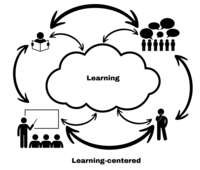
Towards a learning-centered classroom
Following are some ideas to get you started on the path towards a learning-centered classroom.
- Give yourself permission to leave portions of each class unplanned. These can be very short in the beginning, giving you the chance to ease in and develop your attentiveness, responsiveness, and adaptability. For some teachers, these initial forays into unplanned teaching may primarily serve as proof that it’s possible to survive without planning each step.
- Begin taking note of which things reliably work with your classes. You’re looking for tasks that can be used with different content and which your students wouldn’t mind, and would likely benefit from, doing more often. These will become the first tools in your toolbox, ready to be employed when a suitable challenge arises. Perhaps counterintuitively, responsiveness and adaptability suffer from a surfeit of options and flourish when you have but a few well-developed ones.
- Shift the emphasis of your class planning time from what you will do to what you will attempt to achieve. Every minute you spend fleshing out and refining the goal will provide clarity that saves you three minutes on the other end. Somewhat paradoxically, knowing exactly where you are going will free you to be flexible in how you get there. Consider the difference between using GPS to get somewhere you’ve never been as compared with going somewhere you know very well. Whereas in the former, any missed turn feels like a failure, in the latter traffic and construction are simply invitations to try a different route. A clear goal may be the endpoint of a class, but it is the starting point of effective planning.
- Make a habit of asking yourself, during your classes, questions such as:
- What would best support the learning that is taking place (or needs to take place)?
- How might I redirect that learning to better pursue the goal of the class?
- How might I best be of service in this moment?
The Learning-centered opportunity
The move from teacher- to learner-centered education was a necessary one. It recognized and sought to correct the oversights of the previous approach. But no such correction is ever without its own failings. Teacher- versus student-centered learning is a false dichotomy that inaccurately places these two parties at odds with one another: either teachers control the flow of a lesson, or students do. In truth, the success of either party, as measured by the desirable learning that takes place, depends on how it relates to the other. By acknowledging the centrality of this relationship without narrowly defining it, responsiveness and adaptation in service of a shared goal are made possible. It’s about time we invited learning to take the lead.

